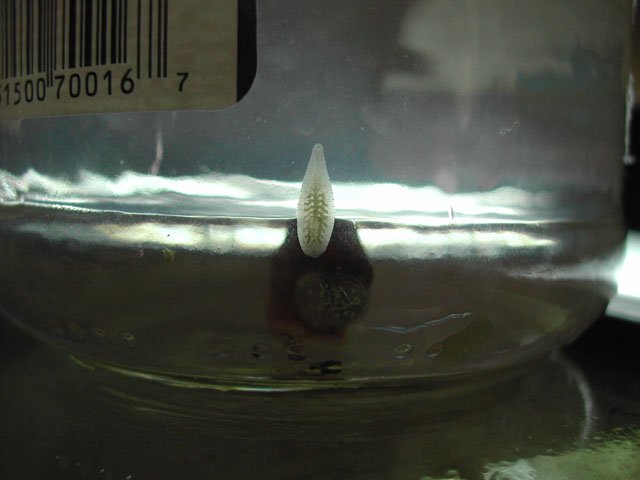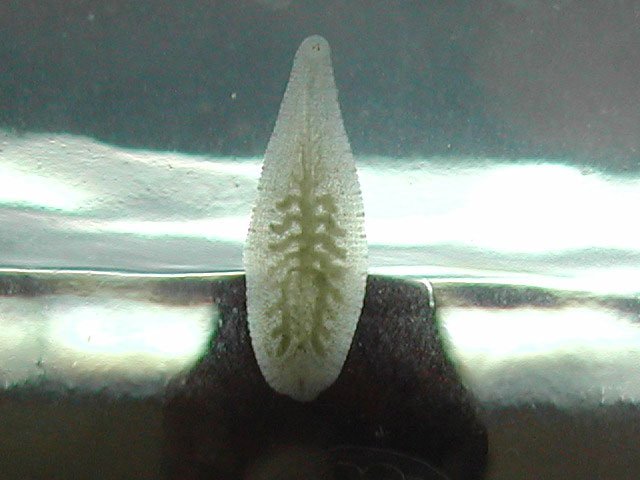I apologize for my verbosity, but I'm not finding much information on The Internets about snail leeches in freshwater aquaria. This seems like a great opportunity to try to change that. captmicha and I can't be the only people to have hitchhiker snail leeches. Can we?
I have one Ramshorn snail and one snail leech in a glass jar for this first experiment. I decided to go with salt alone because I don't have a good way to regulate temperature in the little jar. I started with a dose of 3 teaspoons per gallon, as this seems to be accepted as a higher-end "tonic" dose for freshwater. The Ramshorn and the leech didn't seem to mind. So I waited an hour and then dosed them at 4 tsp/gal. The snail retreated into it's shell, and the leech seemed visibly unhappy, moving around much more than usual. After about 20 minutes the snail had come out of it's shell. Forty minutes later, I dosed them at 5 tsp/gal. Again the snail retreated into it's shell, and the leech looked even more unhappy. It seemed to want to crawl out of the water. An hour later, the snail was still deeply retreated into it's shell and the leech was still moving around near the waterline. So I upped the dose to 6 tsp/gal. The leech curled up and fell to the bottom. It was clearly distressed. It shrank to about 1/8 of it's normal size, as if it had been dessicated, but it did not immediately die. After 30 minutes the snail was still withdrawn into it's shell. Thinking that I had killed the snail but not the leech, I decided to try to save the leech for another experiment. I brought the salinity back down with a few water changes and the leech perked right up. It also turns out that I was wrong about the snail. It eventually came out of it's shell and now seems fine.
My methods were by no means properly scientific, and I only had one subject of each species, but I think I can safely conclude that six teaspoons per gallon is really hard on both Ramshorn snails and snail leeches, at least when administered in a relatively short time (hours, not days). I think a longer time and/or a slightly higher dose might be lethal to one or the other (or both).
I will allow both animals to recover for a week, then I'll probably start another experiment.
I think this time I'll increase the dose a little more rapidly to 8 or 9 teaspoons per gallon, then leave it for maybe 30 minutes. The logic behind this approach is that the snail's shell might offer some protection from the salt over short periods but not long periods, and the plants would probably fare better, too, if they weren't exposed for very long.
I have one Ramshorn snail and one snail leech in a glass jar for this first experiment. I decided to go with salt alone because I don't have a good way to regulate temperature in the little jar. I started with a dose of 3 teaspoons per gallon, as this seems to be accepted as a higher-end "tonic" dose for freshwater. The Ramshorn and the leech didn't seem to mind. So I waited an hour and then dosed them at 4 tsp/gal. The snail retreated into it's shell, and the leech seemed visibly unhappy, moving around much more than usual. After about 20 minutes the snail had come out of it's shell. Forty minutes later, I dosed them at 5 tsp/gal. Again the snail retreated into it's shell, and the leech looked even more unhappy. It seemed to want to crawl out of the water. An hour later, the snail was still deeply retreated into it's shell and the leech was still moving around near the waterline. So I upped the dose to 6 tsp/gal. The leech curled up and fell to the bottom. It was clearly distressed. It shrank to about 1/8 of it's normal size, as if it had been dessicated, but it did not immediately die. After 30 minutes the snail was still withdrawn into it's shell. Thinking that I had killed the snail but not the leech, I decided to try to save the leech for another experiment. I brought the salinity back down with a few water changes and the leech perked right up. It also turns out that I was wrong about the snail. It eventually came out of it's shell and now seems fine.
My methods were by no means properly scientific, and I only had one subject of each species, but I think I can safely conclude that six teaspoons per gallon is really hard on both Ramshorn snails and snail leeches, at least when administered in a relatively short time (hours, not days). I think a longer time and/or a slightly higher dose might be lethal to one or the other (or both).
I will allow both animals to recover for a week, then I'll probably start another experiment.
I think this time I'll increase the dose a little more rapidly to 8 or 9 teaspoons per gallon, then leave it for maybe 30 minutes. The logic behind this approach is that the snail's shell might offer some protection from the salt over short periods but not long periods, and the plants would probably fare better, too, if they weren't exposed for very long.




